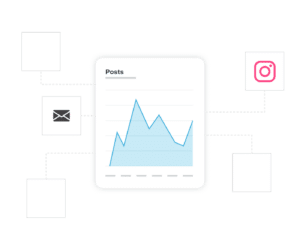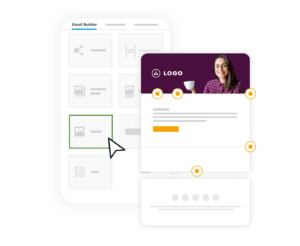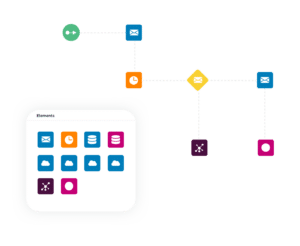How To Maximize Email Lead Generation
The ultimate goal for email is lead generation. Yet, with the endless proliferation of social media channels, some marketers look warily at email as a marketing channel. Even so, 48% of marketers still believe email is the highest performing channel for building brand awareness, nurturing prospects, and increasing conversions.
What’s changed in the last few years is that new automation tools have come along and given marketers the power to refine their nurture campaigns, test and tweak email successes, and fine-tune their efforts on a granular level.
There’s never been a better time to take advantage of email for lead generation.
Email is King
Despite what some marketers might think about the efficacy of email, this fact still stands: 82% of global consumers would rather have businesses communicate with them through email. Compare that to just 12% who prefer communication through mobile apps, and it’s plain to see that email is here to stay.
With that in mind, email should take a front seat in a business’s lead generation strategies. That’s not to say that companies shouldn’t implement other strategies. In fact, email marketing works best when it’s supported with robust content and social media strategies. You need all of them working together to educate leads and entice them into your sales funnel.
After all, lead generation is the process of stimulating buyers and getting them interested in your business’s offerings. This interest is what moves them into your sales funnel as a qualified lead. Yet the businesses with the most success do most of this through email lead generation campaigns.

A Step-by-Step Email Lead Generation Guide
While there are many ways you can use email to generate leads, we’re going to look at it from the perspective of collecting a prospect’s email address so you can nurture them through email campaigns. The objective is to capture them early and keep them engaged until they’ve moved further down your funnel.
You need to entice prospects to share their email address with your business to do this. Generally, it starts with a pop-up or call to action that prompts visitors to enter their email addresses. From there, you can nurture them and, hopefully, entice them to buy into your product or service.
But this is the easy part. The hard part is ensuring everything is in place to support a successful email lead generation campaign.
1. Create an Email Signup Form
The first step in email lead generation is creating a means for your prospects to hand over their email address and contact information. Do it well, and you’ll have a lead-generating machine.
There are a few approaches to email signup forms. If you’ve spent any amount of time perusing the web, you’ve likely seen them all. One of the most popular email signup forms is built into campaign-specific landing pages. These are great if you’ve got a specific marketing campaign built with an enticing offer.
Another popular implementation is the pop-up form. As you might have guessed, pop-up forms are the ones that literally “pop up” on a website when you visit it. Modifications of these are exit forms where the pop-up isn’t triggered until a user tries to close their browser tab or hit the back button.
It’s worth mentioning that pop-up forms can harm a website’s experience if they aren’t implemented tactfully—especially the exit mentioned above forms. Fortunately, you can implement these more gracefully by sticking them in the corner or having them slide in from the side of your site. This makes them less aggressive while still being noticeable and eye-catching.
Regardless of the form you use, the key is to make it simple and easy for visitors to give you their contact details. There are a few things to keep in mind to accomplish this:
- Have a clear CTA that tells your visitors what to do next.
- Keep the form as simple as possible; don’t overcomplicate the process.
- Be sure to tell your prospects what to expect once they’ve signed up.
- Make sure your form is on-brand with relevant colors, images, and copy.
2. Create a Lead Magnet
Some people will offer their email addresses if they’re adequately engaged with your brand. But most need a little more enticing. That’s where a lead magnet comes in.
A lead magnet is something you offer prospects in exchange for their email address. It’s usually a digital product that provides value to your prospect while demonstrating your business’s knowledge and expertise. You’ve no doubt visited a business website that’s offering some small yet valuable digital token for signing up for its newsletter. Some popular lead magnets include:
- Ebooks
- Checklists or product roadmaps
- A video learning series or other content series
- Whitepapers and infographics
Some businesses even use fun and engaging quizzes to entice people to sign up. The point is that the lead magnet should directly relate to your prospect’s needs and align with the value your business offers. This is why lead magnets are great ways to showcase your business’s value and how you solve the prospect’s pain points.
3. Write Great Emails
Writing great marketing emails is an art. But there are a few rules you can abide by to improve your chances of success.

The subject line is the first thing people see when your email lands in their inbox. An effective one should be intriguing and catchy without sounding too spammy. Standing out in a full inbox is challenging, but if you can manage a great subject line, you can break through the noise and get your subscribers to take a look.
When it comes to the content of your emails, less is more. After all, we’re living in the age of instant gratification. If you take too long to get to the point, your readers will lose interest. If you want your email lead generation campaign to work, get your most important message across quickly and make it easy to read.
Be sure to use bold fonts and bulleted lists, so your content is easy to take in. You should also add in an intriguing call to action that invites the lead back to your site for some enticing content or offer.
Lastly, be sure to opt for clean designs. While there’s some debate about whether to send HTML or plain text, there’s a time and a place for both, and it depends on the type of content you’re sending in the email. For example, HTML can lend itself to a marketing feel, such as newsletters or event invitations, while text emails can feel much more personalized. The right marketing automation platform can help you design great emails.
4. Start Nurturing
You have your forms set up. You’re offering an enticing lead magnet to your prospects, and it’s all generating a nice cache of email addresses for your marketing campaign. Now, it’s time to start nurturing your new lead list.
At this state, good website tracking and a better CX platform can help measure and maximize engagement and improve your conversions. By understanding where your visitors are in your sales funnel, you know which emails to send and at precisely the right time. Moreover, you can automate all of this with the right set of tools, resulting in a highly polished lead-generating machine.
And of course, you’ll want to continue education and engagement through ongoing newsletters, content promotions, and event invitations until your leads are primed and ready to be passed over to the sales team.

Why Email Matters
By now, it should be clear how crucial email marketing is to your broader lead generation strategies. If you removed this channel, your leads wouldn’t have scheduled and consistent content from your business in their inbox. Instead, they’d have to go looking for it themselves, and they might find something else on the way.
In today’s world, where your competition is fighting for the exact prospects you are, we have to deliver a variety of interactions to our leads. When you’re executing an email lead generation campaign, it’s best practice to dedicate a good amount of focus to planning your campaign, segmenting your contacts, and building out your email list. Content is a crucial component of your emails, especially with nurture campaigns and newsletters.
With that in mind, here are a few more tips to keep things moving smoothly:
- Publish digital content on websites and social networks to educate potential leads.
- Have multiple calls to action and landing pages available to interested leads.
- Capture leads’ email addresses on lead capture forms, along with additional information like name, industry, job title, and needs from your company.
- Drop leads into email nurture campaigns based on their answers from the lead capture form.
- Continue education through email, event, and content promotion (often implementing a lead scoring model) until they’re ready to be passed to sales.
Leverage the Right Tools
Several platforms and services are available to help businesses manage and maintain their website rather than worrying about what to do with the people who visit it. And while these are invaluable services, it might be worth looking at other alternatives for marketing email management.

Investing in a marketing automation platform can provide your business with the tools to segment email recipients, automate nurture and drip campaigns, track engagement, and implement scoring models. Marketing automation supports your entire email lead generation strategy, streamlines your marketing processes, and automates your entire organization’s lead generation and scoring efforts.
Improve Your Email Marketing With SugarCRM
There’s no denying it: Lead generation through email is crucial to your business’s overall marketing strategy. Not maximizing its effectiveness is leaving prospects on the table for your competition to capture and entice with their enticing content.
SugarCRM brings together sophisticated email marketing automation tools with precision data collection and analytics so you can create successful email marketing campaigns that deliver results.
And we do much more than just email. Our platform provides next-generation capabilities for the thriving digital business. If you’d like to get started with our platform, request a demo with us today.



